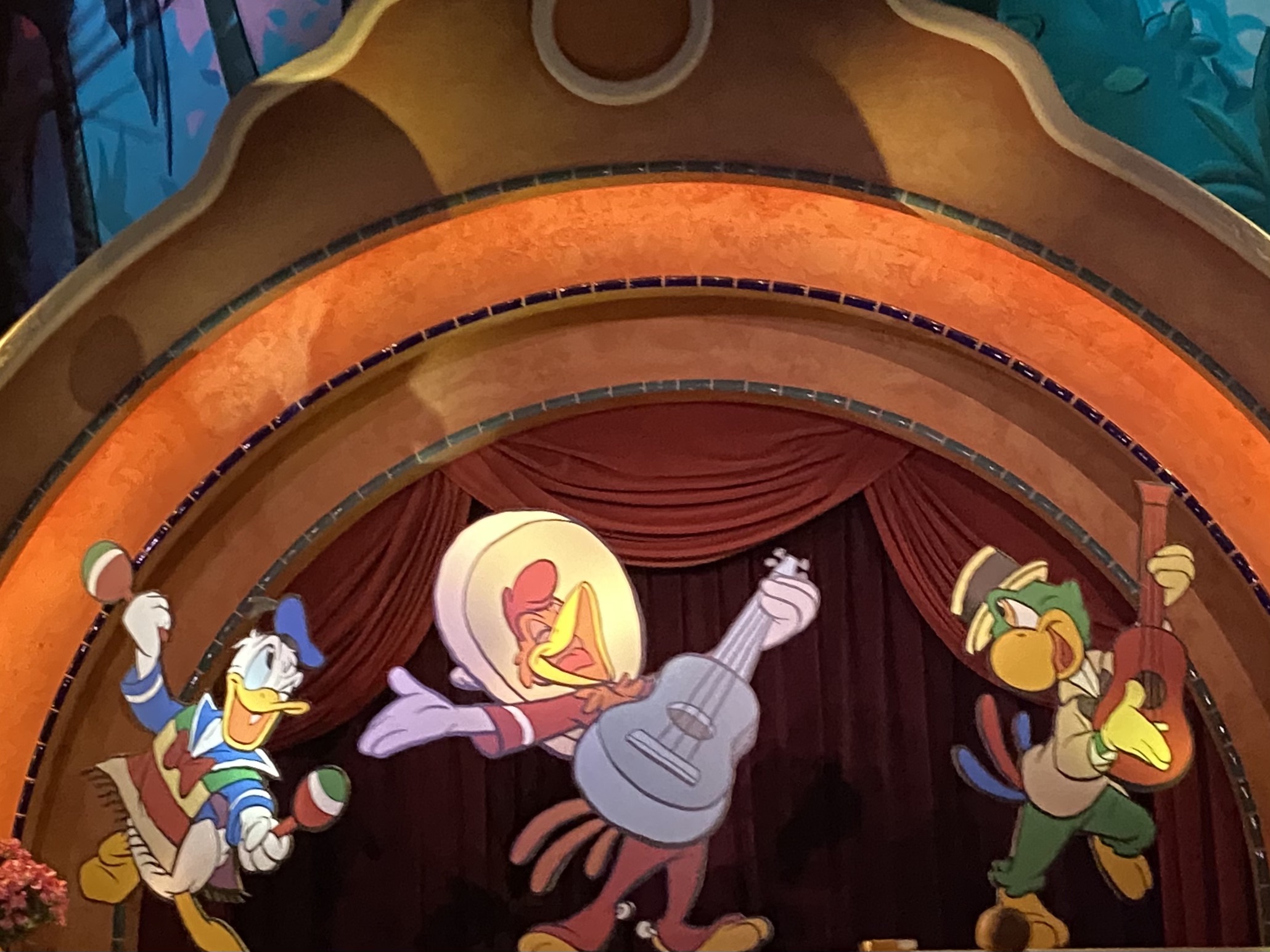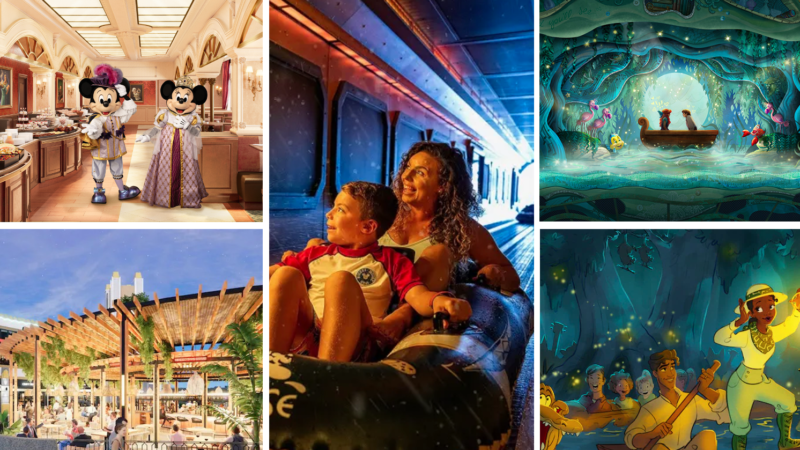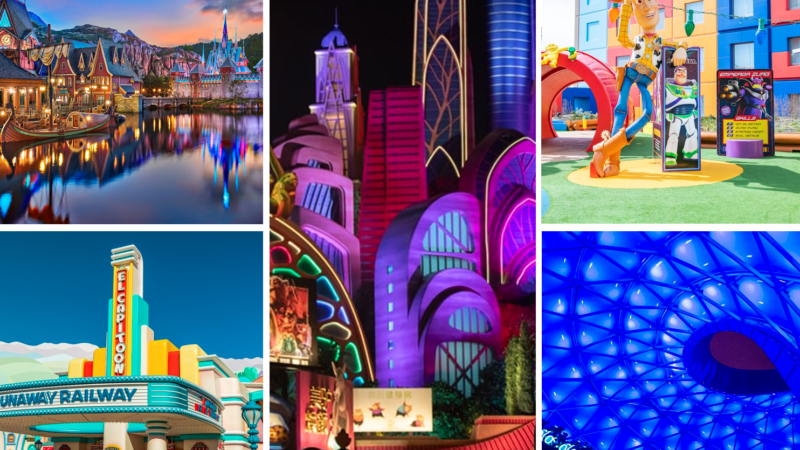Gran Fiasco Tour Starring the Three Cambios

Welcome to this Disney at Work post and podcast. It’s about the Gran Fiesta Tour, but it’s also about change in its different forms. We look at this nearly 40 year old attraction to learn how change occurs and how to best address that change. I’ve called this the Gran Fiasco Tour Starring the Three Cambios.
While the root of the word Fiasco is Flask in Italian, it also has come to literally mean, to “fail in performance”. This perhaps describes well the problem happening to the Three Caballeros animatronics in the attraction where they are missing because of performance failures. Cambios comes from the Spanish cambiar which means to change.
There are three places where the dynamics of change can occur:
- Unexpected Change
- Continuous Improvement and Change
- Anticipated Change
Looking at what is happening at Gran Fiesta Tour, we’re going to explore those concepts of change and how we address them. At the end, we’ll offer you some souvenirs for you and your organization as you consider change and how to embrace it.
You can find the podcast here on Podbean, iTunes, Spotify, MyTuner, and ListenNotes. Please subscribe! We outline our key points below, but our insights are best found on the podcast.
Also, if you like this podcast, we really appreciate you helping out the “littlest podcast that ever could” by visiting iTunes and giving us a positive rating and review. This helps more people find us out there.

Unexpected Change
We all know what unexpected change is. We’re experiencing it during this pandemic. But the theme of this attraction is also rooted in unexpected change.
To set the stage for what was happening at Walt Disney Productions, long before the Pearl Harbor tragedy of December 7, 1941, world events were unfolding and impacting even the tiny Disney Studios in Burbank California. European markets were collapsing; and they were a source of profit for Disney films like Bambi, and Fantasia.
If that were not enough, internal strifes and conflicts within Walt Disney’s organization led to a strike in early 1941. Because of this, Walt was devastated. He saw himself as a very giving employer, who took care of their needs. How could his artists turn against him and go on strike when everyone needed to come together?
Meanwhile, the Nazi and Fascist influence of Germany and Italy had stretched well across the European continent making the U. S. government concerned about its influence on South America. Nelson Rockefeller, Coordinator of Inter-American Affairs, approached Walt about doing a good will tour. Walt resisted the idea, as he simply couldn’t envision himself on some ambassadorial tour. Nelson countered by suggesting he go create a movie down there.
The government also offered to cover travel expenses and provide financial support of the pictures they produced. The offer was enough for Roy Disney to encourage Walt to get away from the studio and allow him to heal the wounds left open by the strike.
Over the duration of this trip members of the team would see Brazil, Argentina, Chile, Bolivia, Peru, Colombia, Panama and Mexico. The result of the trip revolved around two films: Saludos Amigos, and The Three Caballeros–the latter being the influence behind Gran Fiesta Tour Starring The Three Caballeros. Here Donald represents the U.S., Jose represents Brazil, and Panchito represents Mexico.
The work had a positive affect, not only on North and South American relations, but on helping the Walt Disney Productions Studio recover from a bitter strike. Moreover, it has become the center of this attraction here at Epcot. None of this would have happened if unexpected–even terrible, uncontrollable events hadn’t happened. But they did, and by embracing the change rather than refuting them, circumstances only improved.
Like World War II or the Pandemic, you may not be able to unexpected change. But you can act in times of change to make your outcome as favorable as possible.
Continuous Improvement and Change
Nothing is perfect, and most change happens as you go along. In fact, in my work, I talk about the concept of 80/20, meaning that you should get to the 80% completion point, then put it out there and fix the remaining 20% afterwards. There is also a phrase, “Ready, Fire, Aim”. This rephrasing of “Ready, Aim, Fire” is one where you recognize that you may not hit the target until you fire at it. Too many times people never get out of the gate because they’re constantly aiming, waiting for the perfect moment, which simply may not come. Therefore, get yourself ready, shoot toward your target, fire away, and then re-adjust as you go along.
Continuous Improvement is an intentional form of change. That change can come in big and small way. One small example is the load/unload canal where your boat returns so you can disembark. Because of safety concerns that boats can sometimes get “stuck”, thereby blocking everyone else from moving forward on the path, there was a small path originally placed to the right of the canal that would allow passengers to exit in case the boat at the disembark station became stuck.
The problem with this walkway was that guests who had come to a stop waiting for the boat ahead to be disembarked would think they needed to get out as well, and would start to exit to the right. This was very dangerous as their boat could easily begin to move at any time. There were audio announcements and signs put in to remain seated until returning to the dock, but people either didn’t see/hear it, or didn’t understand the language. Eventually, someone came up with a smart idea of having stanchions that could be lowered in case of emergency when guests needed to be exited prior to the disembarkation point. They added images of Panchito, Jose and Donald to better theme it.
This is a small instance. Many of these go unseen to the guests such as software or technology upgrades. But some continuous improvement can be much more noticeable. The move to change Rio del Tiempo into Gran Fiesta Tour is the most obvious. The move to add the three audio-animatronic characters is another.
While a few miss Rio del Tiempo, continuous improvement is usually a positive thing–especially at Disney. Some are fairly well received, like the move from Maelstrom to Frozen Ever After. But there are misses (Journey Into Imagination–I’m looking at you). But as Walt Disney once said:
“Disneyland will never be finished. It’s something I can keep developing, keep plussing and adding to. It will be a living, breathing thing that will always keep changing. Not only can I add new things, but even the trees will keep growing. Disneyland will get more beautiful every year.”
Anticipated Change
When Expedition Everest opened in 2006 the Yeti was perhaps the most complicated built at that time. It was also one of the largest, though large animatronics had been built for Sinbad’s Storybook Journey. But this Yeti was designed not just to gently move or blink its eyes. It was intended to take a swing at you.
Not too long after it opened it began to have problems. This change was unexpected, as Joe Rhode related as he addressed the issue:
“It’s not an issue of maintenance access, they were part of the design team and set the standard. In fact, it was seen as a model collaborative process. It’s an unexpected and unforeseen set of issues, very complex, with no easy or timely solutions as of yet.”
This became known as the Yeti Effect–when an attraction is so dependent on a key animatronic moment that you need a backup plan. The Yeti Effect was the result of our first form of change we spoke of–unexpected change. But what happened thereafter was to create attractions where key animatronics had easy-to-institute backups. So when Kylo Ren goes down at the end of Rise of the Resistance, operations has the ability to put him in the cockpit of a ship out in space facing you through a large porthole. It’s one of the coolest moments, to see this backup, which is shown below:
There is also another one of these with the Shaman of Songs in Na’vi River Journey. The most advanced animatronic Disney has created, it is the highlight of this attraction. So what do you do when she doesn’t work? You slide her back and pull down a screen that shows her image in action. You can see it at the 3:11 mark below:
Here’s the challenge to Gran Fiesta. It’s not a brand new attraction like Na’vi River Journey or an E-Ticket attraction like Expedition Everest, and Rise of the Resistance. It only has three high functioning audio animatronics–the Three Caballeros themselves. You can take the limited animatronic children or skeletons out one at a time from the Colonial scene and have them refurbished. They can even stand there doing nothing and you probably won’t notice. But you notice these three guys. They are the centerpiece of the attraction. They are the climax of the ride. If they’re not working, you notice. Especially when painted wooden cut outs are put in their place. That’s not a replacement.
This is probably the most frustrating aspect. It would seem to me that a Yeti Effect should have been thought of some time ago. Indeed, two viable solutions have been put in place for some time. First of all, when the attraction reopened as Gran Fiesta Tour in 2007, it didn’t have animatronics. It had a beautiful, colorful, whimsical animation scene on the screen of the bowl.

Where is this film? Why isn’t this put back while you take the time to fix the characters? The fact that this isn’t standing as a backup suggests that somebody didn’t take the time to anticipate what it would mean to the attraction if one or more of the characters were not working. To me, that is the most un-Disney thing I can think of–not anticipating. In fact, when the animatronics were put out there, I wondered why they didn’t just keep the film playing in the background to make the experience all the more whimsical.
But it gets worse. They not only don’t have the back up film in place, they any back up animatronics. Does that sound expensive? Not really. Many fans know that these three animatronics came from the Mickey Mouse Revue, which closed in 2009 at Tokyo Disneyland (it originally ran in Magic Kingdom). What most people don’t know or remember is that there is not one but three sets of Three Caballeros. In the Mickey Mouse Revue show, they had them sing, but then they re-emerged at different points from theater balconies. Yes! There are three sets of Three Caballeros. You can see it below in this video:
So this is my frustration–long before a pandemic, why wasn’t a plan put in place that would anticipate the day and moment when one or more of these characters needed down time? This is the Disney Difference–or should be. Paying attention to details others wouldn’t have the time and budget to do. And in this instance, it didn’t take much money because they already had a back up film and two sets of backup animatronics.
Alice Davis, former Imagineer, understood anticipating change. When Pirates of the Caribbean was originally under construction at Disneyland, she was asked to make the costumes. She made them strong enough to not only prevent wear and tear. She made three sets as backups. She wasn’t encouraged to do so. She was told there wasn’t time and budget. But she did it any way, and when a fire happened one day on the attraction and burned the costume of a character, she had others waiting as standbys to be used. That’s Disney–anticipating change. It’s what’s missing at Gran Fiesta Tour that has made it Gran Fiasco Tour.
You can see how this looks currently in the following video. Not only will you see the finale scene with cutouts, but you will also see how they’ve handled the queue during the pandemic, and how the end canal scene is now using stanchions to block people from getting off the boats. The total effect is emblematic of how we deal with and anticipate change–for the good or bad.
Souvenirs for You and Your Organization
As always, this is not about Disney, but you and your organization. Take these complimentary ideas back to your own place of business:
- What is your attitude toward unexpected change? How do you take lemons and make lemonade?
- What has the pandemic taught you about dealing with unexpected change? If the pandemic were to repeat itself again, what would you do differently?
- What does continuous improvement look like in big and small ways?
- What processes can you put in place to allow for continuous improvement and change?
- What experiences have you had that suggest you might need to anticipate changes ahead?
- How do you budget time and money to anticipate expected change?
- How do you set yourself apart in the market place by being more agile to change?
The Wayfinder Society: A Patreon Site for Disney Fans

We are offering a new program where you have the opportunity to enjoy exclusive offerings from Disney at Play and Disney at Work. Join us as we introduce our new Patreon program, the Wayfinder Society, intended to give you new insights to all things Disney, whether its work or play. I am truly excited to share this new opportunity with you and look forward to creating new experiences that you will enjoy whether at home or at the Disney parks. There are a variety of options for joining, depending on your interests:

When you join, you will be given access to unique, interactive apps that explores the parks in new ways, offering stories, photos, videos and more.
Here are some of the interactive apps we share with members of our society:
- Pandora: World of Avatar: This is an expansive and detailed look at every aspect of this land. You can’t find any source that has covered this entire land with its attractions, retail and dining more in depth.
- Pirates of the Caribbean Across the Globe: We not only compare this attraction in parks world-wide, but we deep dive into what makes each unique. Currently we’ve covered Tokyo Disneyland and Magic Kingdom. More to come!
- Coming Soon! S.E.A. Assembled! The Society of Adventurers and Explorers are coming to the Wayfinder Society. We’ll document their whereabouts and showcase their imprint on Disney attractions world-wide.
- Disney at Work Interactive Tour: Disneyland. For our upper tiers, we have an interactive business tour of Disneyland to include more than fifty attractions spread throughout the park. These are best-in-business ideas you can apply to your own organization.
- Coming Soon! Disney at Work Interactive Tour: Walt Disney World 50th Anniversary. Looking at the heritage of Most Magical Place in the World, we draw best practices from over the years that you can again, apply to your organization.
As you see, we have so much to share. And when you donate, a portion of your contribution goes to Embrace Celebration, dedicated to helping Disney Cast Members and others in this area who are unemployed during this pandemic. To learn more, visit our site to discover our offerings and various tiers. Join us!





